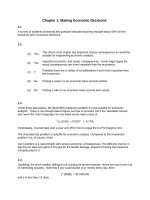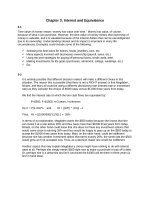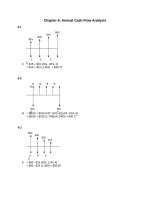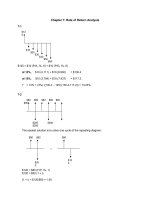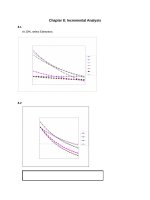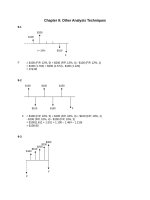Solution manual engineering economic analysis 9th edition ch18 accounting and egineering economy
Bạn đang xem bản rút gọn của tài liệu. Xem và tải ngay bản đầy đủ của tài liệu tại đây (76.58 KB, 6 trang )
Chapter 18: Accounting and Engineering Economy
18-1
Engineers and managers make better decisions when they understand the “dollar” impact of
their decisions. Accounting principles guide the reporting of cash flows for the firm.
Engineers and managers can access this information through formal and informal education
means, both within and outside the firm.
18-2
The accounting function is the economic analysis function within a company it is
concerned with the dollar impact of past decisions. It is important to understand, and
account for, these past decisions from management, operational, and legal perspectives.
Accounting data relates to all manner of activities in the business.
18-3
Balance Sheet – picture of the firm’s financial worth at a specific point in time.
Income Statement – synopsis of the firm’s profitability for a period of time.
18-4
Short-term liabilities represent expenses that are due within one year of the balance sheet,
while long-term liabilities are payments due beyond one year of the balance sheet.
18-5
The two primary general accounting statements are the balance sheet and the income
statement. Both serve useful and needed functions.
18-6
Today’s weather is not a good basis to pack for a 3-month trip, and local and recent financial
data is not a complete basis for judging a firm’s performance. Historical and seasonal
trends and a context of industry standards are also needed.
18-7
Not necessarily. The current ratio will provide insight into the firm’s solvency over the short
term and although a ratio of less than 2 historically indicates there could be problems, it
doesn’t mean the company will go out of business. The same is true with the acid-test ratio.
If the company has a low ratio, then it probably doesn’t have the ability to instantly pay off
debt. That doesn’t necessarily indicate the firm will go bankrupt. Both tests should be used
as an indicator or warning sign.
18-8
Assets = $1,000,000
Total liabilities = $127,000 + 210,000 = $337,000
Equity = assets – liabilities = $1,000,000 – 337,000 = $663,000
18-9
6 days/week * 52 weeks/year = 312 days/year in operation
$1000 profit/day * 312 days/year = $312,000 profit/year
Revenues – expenses = $500,000 – 312,000 = $188,000
18-10
a. Working capital = current assets - current liabilities
= $5,000,000 – 2,000,000
= $3,000,000
b. Current ratio = (current assets / current liabilities)
= $5,000,000/2,000,000
= 2.5
18-11
Net profit (loss) = revenues – expenses = $100,000 – 60,000 = $40,000
18-12
a. Working capital = ($90,000 + 175,000 + 210,000) – (322,000 + 87,000)
= $475K – 409K = $66,000
b. Current ratio = ($475K/409K) = 1.161
c. Acid test ratio = ($90,000 + 175,000)/409,000 = 0.648
18-13
Operating Revenues and Expenses
Revenue
Sales
Total
30,000
30,000
Expenses
Administrative
Cost of goods sold
Development
Selling
Total
Total operating income
2750
18,000
900
4500
26,150
3,850
Non-operating revenues & expenses
Interest paid
Income before taxes
Taxes (@27%)
Net profit (loss)
200
3650
985.50
2664.50
18-14
Assets = $100,000 + 45,000 + 150,000 + 200,000 + 8,000 = $503,000
Liabilities = $315,000 + 90,000 = $405,000
a. Working capital = $503,000 – 405,000 = $98,000
b. Current ratio = $495,000/405,000 = 1.22
c. Acid test ratio = $295,000/405,000 = 0.73
18-15
a. Working capital = current assets – current liabilities
= ($110K + 40K + 10K + 250K) – (442K) = $118,000
b. Current ratio = current assets / current liabilities
= $560K/442K = 1.27
c. Acid test ratio = quick assets / current liabilities
= $310K/442K = 0.701
A good current ratio is 2 or above, and a good acid test ratio is 1 or above. This company is
in major trouble unless they move inventory quickly.
18-16
Total revenues = $51 + 35 = $86 million
Total expenses = $70 + 7 = $77 million
a. Net income before taxes = revenue – expenses = $86 – 77 = $9 million
b. Net profit = net income before taxes – taxes = $9 – 1 = $8 million
Interest coverage = (total revenues – total expenses) / interest
= ($86 – 70)/7 = 2.28
This interest coverage is not acceptable because it should be at least 3.0 for industrial
firms.
18-17
Profit = $50,000 – 30,000 – 5,000 = $15,000
Net income = profit – taxes = $15,000 – 2,000 = $13,000
18-18
a. Current ratio = current assets / current liabilities = (1.5million)/50,000 =30
b. Acid test ratio = quick assets / current liabilities = (1.0 million)/50,000= 20
While it may be tempting to think that a higher ratio is better, this is not always the case.
Such high ratios as these could mean that an excessive amount of capital is being kept on
hand. Excess capital does very little for the company if it is just sitting in the bank – it could
and/or should be used to make the company more profitable through investing, automation,
employee training, etc.
18-19
Total current assets = $1740 + 900 + 2500 – 75 = $5065
Total current liabilities = $1050 + 500 + 125 = $1675
Current ratio = $5065/1675 = 3.0238
This company’s financial standing is good because the current ratio is greater than 2.0.
18-20
a. Current ratio = current assets / current liabilities = $2670/1430 = 1.87
This is below the recommended ratio of 2.0 and may indicate that the firm is not solvent,
especially since the height of the nursery business is the spring and summer and this is a
June balance sheet.
b. Acid test ratio = (cash + accounts receivable) / current liabilities
= ($870 + 450)/1430 = 0.92
This indicates that 92% of the current liabilities could be paid out within the next thirty days,
which is not a bad situation, although a little higher would be preferable.
18-21
a. Interest coverage
= total income / interest payments
= ($455 – 394 + 22)/22 = 3.77
This is a good ratio, indicating the company’s ability to repay its debts. It should be at
least 3.0.
b. Net profit ratio = net profits / sales revenue = $31/(395 – 15) = 0.08
This is a very small ratio, indicating that the company needs to assess their ability to
operate efficiently in order to increase profits. The company should compare itself to
industry standards.
18-22
Activity
Direct material cost
Direct labor cost
Direct labor hours
Allocated overhead
Total costs
Units produced
Cost per unit
Model S
$3,800,000
$600,500
64,000
64,000 X 137 =
$8,768,000
$131,685,000
100,000
$132
Model M
Model G
$1,530,000
$2,105,000
$380,000
$420,000
20,000
32,000
20,000 X 137 = 32,000 X 137 =
$2,740,000 $4,384,000
$4.650,100
$6,909,000
50,000
82,250
$93
$84
18-23
a. Total direct labor = 50,000 + 65,000 = $115,000
Allocation of overhead
OverheadStandard = (50,000/115,000)(35,000) = $15,217
OverheadDeluxe = (65,000/115,000)(35,000) = $19,783
Total CostStandard = 50,000 + 40,000 + 15,217 = $105,217
Total CostDeluxe = 65,000 + 47,500 + 19,783 = $132,283
Net RevenueStandard = 1800(60) - 105,217 = $2783
Net RevenueDeluxe = 1400(95) - 132,283 = $717
b. Total materials = 40,000 + 47,500 = $87,500
Allocation of overhead
OverheadStandard = (40,000/87,500)(35,000) = $16,000
OverheadDeluxe = (47,500/87,500)(35,000) = $19,000
Total CostStandard = 50,000 + 40,000 + 16,000 = $106,000
Total CostDeluxe = 65,000 + 47,500 + 19,000 = $131,500
Net RevenueStandard = 1800(60) - 106,000 = $2000
Net RevenueDeluxe = 1400(95) - 131,500 = $1500
In both cases the total net revenues equal $3500, but the deluxe bag appears far more
profitable with materials-based allocation.
18-24
a. $60,000,000/12,000 hours = $5000/hour
b. Total cost = $1,000,000 + $600,000 + 200hours*$5000/hour = $2,600,000
18-25
RLW-II will use the ABC system to understand all of the activities that drive costs in their
manufacturing enterprise. Based on the presence and magnitude of the activities, RLW-II
will want to assign costs to each. In doing this, RLW-II will gain a more accurate view of the
true costs of producing their products. Potential categories of indirect costs that RLW-II will
want to account for include costs for: ordering from and maintaining a relationship with
specific vendors/suppliers; shipping, receiving, and storing raw materials, components and
sub-assemblies; retrieval and all material handling activities from receiving to final shipment;
all indirect manufacturing and assembly activities that support the direct costs; activities
related to requirements for specific and unique machinery, tools and fixtures, and
engineering and technical support; all indirect quality related activities in areas such as
testing, rework and scrap; activities related to packaging, documentation and final storage;
shipping, distribution and warehousing activities, and customer support/service and warranty
activities.
18-26
Direct Costs
Machine operator wages
Machine labor
Overtime expenses
Cost of materials
Indirect Costs
Insurance costs
Utility costs
Material handling costs
Engineering drawings
Cost to market the product
Cost of storage
Cost of product sales force
Support staff salaries
Cost of tooling and fixtures
Machine run costs
